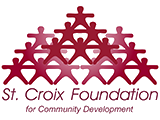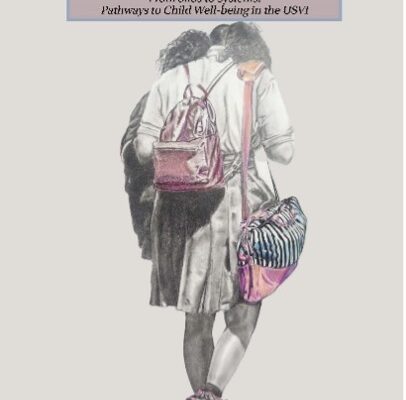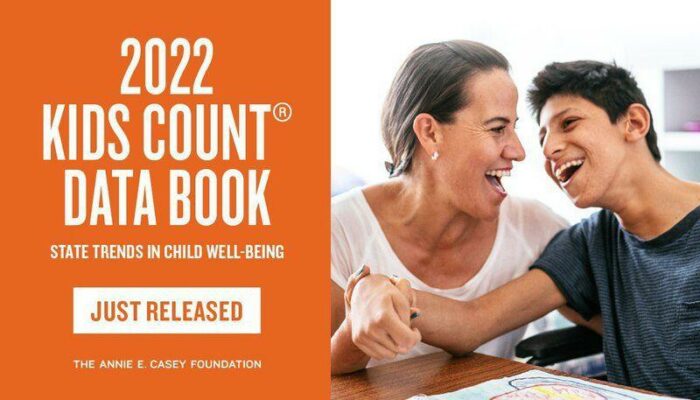ST. CROIX, U.S. Virgin Islands (USVI) – Recent national data indicates that child care in America has become “inaccessible and unaffordable,” according to the 2023 KIDS COUNT® Data Book, a 50-state report of recent household data developed by the Annie E. Casey Foundation analyzing how children and families are faring. (Note that the U.S. Virgin Islands is not included in the National KIDS COUNT® Data Book as it draws data from the American Community Survey, which is not conducted in the territory.) The annual report also sheds light on other challenges, including those surrounding education, health, and the economy that are affecting American children. Each year, the Data Book presents national and state data from 16 indicators in four domains — economic well-being, education, health, and family and community factors — and ranks the states according to how children are faring overall.
To supplement available national data, each year the KIDS COUNT USVI team publishes a Data Book focused specifically on the USVI that reports available data aligned with the four domains of the national Data Book.
As published in the 2022 KIDS COUNT USVI Data Book, there was an increase in the percentage of WIC-receiving mothers who reported breastfeeding, from 60% in 2020 to 72% in 2022. This represents the highest breastfeeding percentage of all WIC State agencies in Fiscal Year 2021, according to the US Department of Agriculture. (WIC – the Special Supplemental Nutrition Program for Women, Infants, and Children – provides federal grants to states for supplemental foods, health care referrals, and nutrition education for low-income pregnant, breastfeeding, and non-breastfeeding postpartum women, and to infants and children up to age 5 who are found to be at nutritional risk.) While the data is specific to mothers enrolled in WIC, this high rate is a bright spot for our community. Benefits of breastfeeding include giving infants a healthier start with a stronger immune system, in contrast to a heavy reliance on formula products, which left many mothers without viable options during recent supply shortages in the 50 states.
Of course, access to early childhood education and child care options are key for working parents. According to the USVI KIDS COUNT Data Book, 112 USVI children participated in Early Head Start and another 582 students were enrolled in Head Start. Additionally, there were 102 students in public school Pre-K programs. Taken together, this accounts for 18% of children under age 5 in the USVI (there were 4,468 children under 5 in the USVI per the 2020 Census). Unfortunately, this leaves 82% of children under age 5 who are not attending affordable Pre-K nor enrolled in a licensed child care facility, a gap which is likely to leave parents facing difficult choices about care options should they need or desire to work outside of the home.
The 2023 KIDS COUNT® Data Book further reports that too many parents cannot secure child care that is compatible with work schedules and commutes. For example, in 2020—21, 13% percent of children under age 6 had a family member who quit, changed, or refused a job because of problems with child care. And women are five to eight times more likely than men to experience negative employment consequences related to caregiving. Even if parents can find an opening at child care near their home, they often can’t pay for it. The nation’s average cost of center-based child care for a toddler in 2021 was $10,600, one-tenth of the median income of a married couple.
In the USVI, the median cost of center-based child care was approximately $6,000 annually, according to a USVI Department of Human Services survey published in 2022. This represents 15% of the median household income in the USVI as reported from the 2020 Census. According to the national Data Book, shortcomings of the child care system disproportionately affect the financial well-being of women, single parents, parents in poverty, families of color, and immigrant families.
While the cost of care burdens families, child care workers are paid worse than 98% of professions. Median national pay for child care workers was $28,520 per year or $13.71 an hour in 2022, less than the wage for retail ($14.26) and customer service ($18.16) workers. In the U.S. Virgin Islands, the mean annual wage for child care workers is $26,430, according to the USVI Department of Labor.
The failings of the child care market also affect the current and future health of the American economy, costing $122 billion a year in lost earnings, productivity and tax revenue, according to one study. All of these challenges put parents under tremendous stress to meet the dual responsibilities of providing for their families and ensuring their children are safe and nurtured.
According to Casey, transitioning from a faltering child care system to creating a flourishing one will take new thinking and investing at the local, state, and national levels. An executive order issued by President Biden in April is aimed at expanding access, lowering costs, and raising wages. It could prove to be a helpful framework, but more is needed:
- Federal, state, and local governments should invest more in child care. State and local governments should maximize remaining pandemic recovery act dollars to fund needed child care services and capacity. Congress should reauthorize and strengthen the Child Care and Development Block Grant Act and increase funding for public pre-kindergarten and Head Start.
- Public and private leaders should work together to improve the infrastructure for home-based child care, beginning by lowering the barriers to entry for potential providers by increasing access to start-up and expansion capital.
- To help young parents, Congress should expand the federal Child Care Access Means Parents in School (CCAMPIS) program, which serves student parents.










